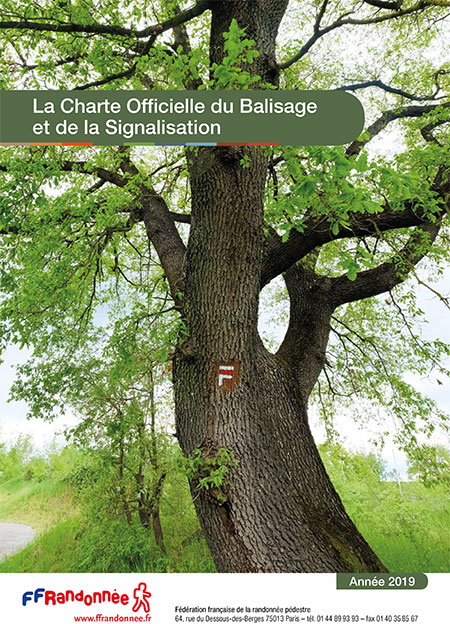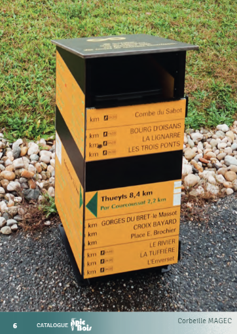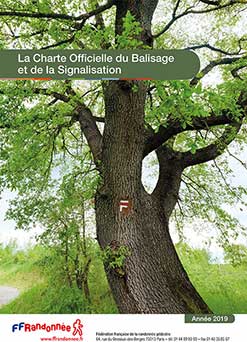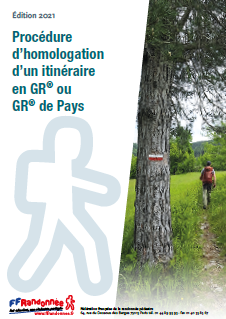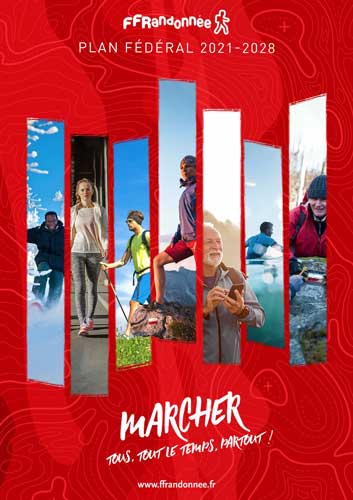La fédération
-
RecrutementRecrutement
Stages
Publié le 11 avril 2023Chargé(e) de mission itinérance douce - Comité régional de la randonnée pédestre de Haute-Garonne
Le stagiaire, par une mission de 4 à 6 mois au sein du comité départemental de randonnée pédestre de la Haute-Garonne, représentant la Fédération Française de Randonnée, sera chargé de mener une étude d’opportunité technique pour la création d’une dorsale en itinérance douce sur le territoire du PETR Pays Tolosan.
Lieu de travail :
Bureau du Comité Départemental de Randonnée Pédestre de la Haute-Garonne (CDRP31) : 5 Port Saint-Sauveur 31000 Toulouse, télétravail possible et à définir pour une partie des activités.
Contraintes du poste : déplacements fréquents et réguliers sur l’ensemble du territoire du PETR Pays Tolosan (autour de Cadours, Grenade-sur-Garonne, Fronton, Villemur-sur-Tarn et Verfeil).Compétences :
• Formation de type tourisme, géographie, développement territorial, géographie, aménagement, niveau minimum BAC+3
• Connaissance de la structure administrative du département et du fonctionnement des collectivités locales et leurs mandataires (OTSI).
• ...Apprenti.e. - Comité régional de la randonnée pédestre des Hauts de France - 1 an
Intégrée au sein de l'équipe de salariés du Comité régional et placée sous la responsabilité de l’élu en charge de la commission tourisme et internationale, la personne sera chargée de les accompagner sur :
- Le montage de produits touristiques autour de la randonnée
- L’organisation du festival trek randonnée du 4 au 11 juin 2023 (rassemblement européen de 600 à 800 randonneurs) sur le littoral.Type de contrat
- Le poste est en contrat d’apprentissage d’un an et est à pourvoir au 15 juin 2022
- Permis B, déplacements régionaux
- ...Candidature à adresser pour le 25 mai au plus tard :
• par mél à : hauts-de-france@ffrandonnee.fr
• ou par courrier à
Monsieur le Président
Comité régional de la randonnée pédestre des Hauts de France
Maison des sports
2 rue Lescouvé
80000 AMIENSStage FFRandonnée Ain
Mission de stage :
La FFRandonnée Ain souhaite auditer 10 de ses itinéraires de Promenade Randonnée sur le secteur du Val de Saône.
Le stagiaire aura pour mission de :- parcourir les itinéraires dans leur intégralité et relever les éventuels problèmes,
- faire l’inventaire du mobilier signalétique randonnée en place et préconiser de nouveaux points d’implantation,
- Faire l’inventaire des tronçons nécessitant un renforcement en balisage.
Compétences requises :
- Etudiant en Géographie / Aménagement du territoire / Tourisme / Sport / Montagne / Cartographie
- Autonomie, rigueur, organisation- Aisance en orientation/lecture de carte IGN TOP25/utilisation GPS rando
- Pratique personnelle de la randonnée pédestre
- Informatique (logiciels bureautiques + la connaissance du logiciel SIG Qgis est un plus)Conditions :
- Durée : 2 mois (entre mai et août 2023, à définir selon le calendrier universitaire de l’étudiant stagiaire).
- Remboursement des frais de déplacement.- Compensation financière.
- Lieu du stage : siège de la FFRandonnée Ain (34 rue du Général Delestraint à Bourg-en-Bresse), télétravail possible certains jours.- Véhicule personnel indispensable pour se rendre au point de départ des randonnées.
- VTT personnel souhaitable pour parcourir les itinéraires.
Contacts/candidatures :
Candidature : CV et lettre de motivation (+ possibilité de joindre également des travaux déjà réalisés) à envoyer avant le 23 avril 2023 par mail à : ain@ffrandonnee.fr à l’intention de Francis BEAUVAIS, Président de la FFRandonnée Ain.
Pour plus de renseignements : Sophie CHAPUIS, agent de développement FFRandonnée Ain (schapuis@ffrandonnee.fr / 04 26 37 60 10)DEPOSER UNE CANDIDATURE SPONTANEE
La Fédération Française de la Randonnée Pédestre
En première position parmi les activités sportives les plus pratiquées avec plus de 18 millions de randonneurs réguliers, la Fédération Française de la Randonnée Pédestre bénéficie d’un ancrage territorial développé : 116 comités régionaux ou départementaux, 3450 clubs, 180 000 km de sentiers balisés en France et Outremer, et 230 000 licenciés.
Développer la randonnée pédestre en France comme pratique sportive, contribuer à la sauvegarde de l'environnement et valoriser le tourisme vert et les loisirs, sont les grandes missions que s'est donnée la FFRandonnée depuis sa création. Elle souhaite poursuivre son développement en renforçant et en consolidant les compétences de son réseau ainsi qu’en proposant à l’avenir de nouveaux services et produits adaptés aux randonneurs.
En juin 2016 la FFRandonnée lance le premier portail de référence national, source d’informations et de services exclusifs et inédits dédiés à l’itinérance sur les GR® de France. Plus d’informations sur : www.ffrandonnee.fr et www.mongr.fr
La FFRandonnée est engagée dans une refonte du cursus de formation de ses animateurs qui débouchera à terme sur une évolution des méthodes et des outils pédagogiques (introduction de la formation ouverte à distance par exemple).
Candidature spontanée : CV et lettre de motivation à adresser à recrutement@ffrandonnee.frThématiques : -
RecrutementRecrutement
Emplois
Publié le 02 juillet 2025> OFFRES D'EMPLOIS DU SIEGE NATIONAL Ivry-sur-Seine (94)
Candidature spontanée
La Fédération recrute régulièrement. Si notre association vous intéresse n’hésitez pas à nous faire parvenir votre candidature spontanée (CV actualisé avec lettre de motivation précisant les missions qui pourraient vous intéresser) à l’adresse suivante : recrutement@ffrandonnee.fr
A bientôt !
Thématiques : -
Espace professionnelsEspace professionnels
Signalétique de randonnée : partenariat FFRandonnée et Pic Bois
Publié le 14 mars 2023Partenariat FFRandonnée et Pic Bois
Fournisseur agréé de signalisation
La Fédération Française de la Randonnée Pédestre a publié en 2019 la 4ème Charte officielle du balisage et de la signalisation. Issue de l’expérience de son réseau, cette charte s’appuie sur des valeurs fondamentales :
- La qualité : les éléments de la charte doivent bénéficier d’une garantie de durabilité des matériaux et des couleurs.
- Le respect de l’environnement : les choix des matériaux et des procédés sont faits en fonction des normes en vigueur et de leur impact environnemental.
- La continuité territoriale : l’ensemble du territoire doit disposer de mobiliers de même conception et de même qualité de fabrication.
> Cliquer sur l'image pour télécharger la charte
FFRandonnée et PIC BOIS reconduisent leur partenariat !
La Fédération française de la randonnée pédestre et le groupe PIC BOIS renouvellent leur collaboration par la rédaction conjointe de fiches techniques pour favoriser l’implantation d’une signalétique soucieuse de développement durable sur les territoires. Ces fiches sont destinées à apporter des premiers éléments de réponses techniques pragmatiques aux collectivités.
> Télécharger les fiches techniques FFRandonnée Pic Bois :
- fiche 1 : les matériaux adaptés à l'installation en extérieur
- fiche 2 : les procédés de marquage adaptés à l'installation en extérieur
- fiche 3 : descriptifs techniques et cahier des charges : les questions à se poser
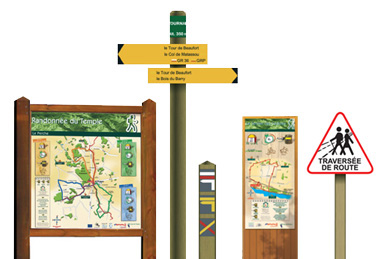
Même dans la signalétique, on recycle !
Accompagné par l’ADEME, Pic Bois s’engage dans la réutilisation des matériaux des mobiliers outdoor voir ici, notamment en développant une gamme fabriquée à partir de lames de sentiers réemployés, voir ici.
Cette action dont on ne peut que saluer l’initiative, s’inscrit dans le plan d’actions 2021/2028 de la Commission Ecologie, Biodiversité, Développement durable, au travers de la loi du 10 février 2020 relative à la lutte contre le gaspillage et l’économie circulaire dite Loi AGEC.
Nous incitons les comités à adresser à Pic Bois les mobiliers usagés et/ou non utilisés, et à relayer le message auprès de leurs partenaires, acteurs sur les territoires.
Thématiques : -
Espace professionnelsEspace professionnels
Les ouvrages techniques d'aménagement
Publié le 14 mars 2023Le Guide du droit des chemins
Consultation indispensable avant de créer un itinéraire
Ce guide technique a pour mission d’aider le créateur d’itinéraires en lui apportant des réponses précises aux questions qu’il se pose et en le mettant en garde sur les aspects fondamentaux du régime juridique des chemins. Cette version rédigée dans un langage simple et accessible à tous, intègre les derniers textes législatifs et jurisprudences.
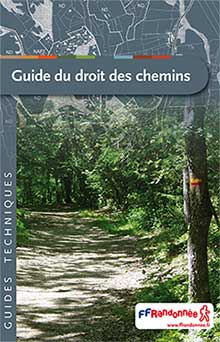
Ouvrage en rupture de stock
La charte officielle du balisage et de la signalisation (édition 2019)
Cette nouvelle Charte a été réalisée avec la précieuse collaboration du ministère des Sports. C'est un référentiel qui définit les règles applicables pour le balisage des itinéraires de randonnée pédestre. Des préconisations et conseils techniques sont également proposés en matière de signalisation dans le respect des caractéristiques environnementales, paysagères et humaines que présentent les espaces dévolus à la randonnée.
> Télécharger la charte officielle du balisage
> Télécharger la charte technique et graphique
En complément de la Charte intégrale, la FFRandonnée a édité un document présentant les principes fondamentaux relatifs au balisage d’itinéraires de randonnées non motorisés et à son entretien dans le respect des milieux, résumés en neuf articles à télécharger ici
La procédure d'homologation d'un itinéraire en GR® ou GR® de Pays (édition 2021)
Ce document précise en quoi consiste l'homologation en GR® et GR® de Pays, apporte quelques informations sur le contexte dans lequel s'insère cette homologation et détaille les étapes à suivre pour constituer le dossier de candidature.
Il est à noter que le sigle GR® ainsi que les balises blanc et rouge sont des marques déposées par la Fédération Française de la Randonnée Pédestre auprès de l'Institut National de la Propriété Industrielle. L'apposition sur le terrain, de ces balises, n'est pas autorisée avant l'obtention de l'homologation.
> Télécharger la procédure d'homologation d'un itinéraire en GR® ou GR® de Pays
Thématiques : -
Qui sommes-nous
- Notre histoire
- Notre organisation
- Nos missions
- La propriété intellectuelle fédérale
- Nos textes officiels
- Comité Éthique et Déontologique
- Commissions disciplinaires
- Lutte contre les violences "Tous Concernés"
- L'espace fédéral
- Citoyenneté
- Le plan fédéral 2021 - 2028
- Rapport d'activité de la FFRandonnée
- Partenaires institutionnels
Qui sommes-nousLe plan fédéral 2021 - 2028
Publié le 12 juin 2024 >> English version
>> English versionLe plan fédéral FFRandonnée 2021-2028 a été adopté par l’Assemblée générale du 17 avril 2021.
L’ambition de ce plan : « Marcher, tous, tout le temps, partout ! » Pour une fédération rayonnante, attractive et légitime.Plan fédéral FFRandonnée 2021 - 2028
Rappel historique
De 1947 à 1978, le Comité National des Sentiers de Grande Randonnée a été une structure de conception et de création d’itinéraires.
De 1978 aux années 2010, le C.N.S.G.R. devient une fédération sportive qui constitue des clubs, forme des animateurs, met en place la formation, la licence… tout en continuant à gérer et développer les itinéraires.
La FFRandonnée se définissait alors comme « marchant sur ses deux pieds », les itinéraires et les pratiques (associatives).
Depuis 2010, elle a encore diversifié ses activités (lancement de nouvelles pratiques, mise en œuvre du Programme Numérique Fédéral) mais elle s’est aussi emparée de grands sujets de société (la sédentarité, le vieillissement de la population, la cohésion sociale, le slow tourisme, la santé). Plus récemment, elle a souhaité s’engager sur le changement climatique et la transition écologique avec, notamment, la marche en ville.
Un renouveau en 2021
À l'ère 2021, la présidente Brigitte Soulary et la co-présidente Madeleine Lebranchu se sont fortement engagées à insuffler un air de renouveau au sein de la Fédération à l'horizon de 2028, pour camper une fédération plus rayonnante, plus attractive et plus légitime :"Plus forte de nouveaux adhérents, de nouvelles communautés de randonneurs, de nouveaux outils et services numériques avec l’objectif collectif des 500 000 licenciés. Plus forte de l’engouement des Français pour la randonnée année après année et encore d’avantage depuis la crise sanitaire. Plus forte de son engagement pour faire de la France une nation plus sportive au moment des Jeux Olympiques et Paralympiques de 2024 et de leur héritage. Plus forte de son investissement dans le développement des mobilités actives, notamment dans les milieux urbains et péri-urbains. Plus forte de ses actions pour un tourisme pédestre plus responsable et une meilleure protection de l’environnement et de son « stade ». Plus forte de publics et de pratiques diversifiés et d’une contribution renforcée à l’amélioration de la santé des Français et à la lutte contre la sédentarité. Plus forte de l’enthousiasme toujours renouvelé de ses bénévoles et de son réseau de clubs et de comités, sur l’ensemble du territoire métropolitain et ultra-marin".
Lire le livret de présentation du plan fédéral 2021-2028
► Faire de la FFRandonnée un acteur majeur des Sports de nature
- Développer le stade
- Positionner la FFRandonnée au cœur des sports de nature
- Mettre en place des stratégies ambitieuses pour étendre l’influence de la FFRandonnée
► Cultiver avec fierté un esprit fédéral partagé
- Faire du club un échelon moteur et innovant
- Encourager un fonctionnement associatif partagé avec les différents échelons fédéraux
- Développer la formation comme un outil de structuration
► Faire de la FFRandonnée un acteur social majeur répondant de manière créative à une demande de pratique évolutive
- Mieux connaître les évolutions de la demande sociale de pratique et renouveler l’offre fédérale (et interfédérale) pour tous
- Réaffirmer le positionnement de la FFRandonnée sur les grands sujets de société
Thématiques : -
English version
- The organisation
- Our missions
- Federal plan 2021 - 2028
- Our history
- The FFRandonnée activity report
- Institutional partners
- Discover the long-distance hiking routes GR®
- The history of the GR® routes
- Waymarking of hiking routes
- Hiking
- Nordic Walking
- Bungy Pump
- Health Hiking
- Endurance hikes and Audax
- Fast Hiking
- Rando Challenge
- Snowshoeing
English versionFederal plan 2021 - 2028
Publié le 02 octobre 2023The FFRandonnee Federal Plan 2021-2028 was adopted by the general assembly on April 17, 2021.
The aim of the plan: “Walk, everyone, every day, everywhere!”. For a radiant, attractive, and legitimate federation
The FFRandonnee Federal Plan 2021-2028
Historical background
From 1947 to 1978, the Comité National des Sentiers de Grande Randonnée was a structure designing and creating routes.
From 1970 to the 2010s, the C.N.S.G.R. became a sports federation, creating clubs, training activity leaders, implementing training and the licence... while continuing to manage and develop routes.
At the time, the FFRandonnée defined itself as "standing on its own two feet" - the routes and the activities.
Since 2010, it has further diversified its activities (launching new activities, and implementing the Federal Digital Programme), but it has also taken on major social issues (sedentary lifestyle, ageing population, social cohesion, slow tourism, and health). More recently, it has decided to commit itself to climate change and the ecological transition, particularly through urban walking.
A revival in 2021
As we enter the 2021 era, President Brigitte Soulary and Co-President Madeleine Lebranchu have made a strong commitment to breathe new life into the Federation by 2028, to create a Federation that is more radiant, more attractive and more legitimate. : “Strengthened by new members, new hiking communities, and new digital tools and services, with the common objective of 500,000 members. Strengthened by French people’s enthusiasm for hiking, we hope, after this unprecedented health crisis. Strengthened by its commitment to make France a more sporting nation at the time of the Olympic and Paralympic Games of 2024 and their heritage. Strengthened by its investment in developing active mobility, especially in urban and peri-urban areas.
Strengthened by its actions in favour of more responsible pedestrian tourism and better protection of the environment and its “stadium”. Strengthened by diversified audiences and practices and a stronger contribution to improving the health of French people and the battle against a sedentary lifestyle. Strengthened by the ever-renewed enthusiasm of its volunteers and its network of clubs and committees across mainland and overseas territory.”
Read the presentation booklet of the federal plan 2021-2028
► Make the FFRandonnnée a major player in outdoor sports
- Develop the stadium
- Establish the FFRandonnée at the heart of outdoor sports
- Set up ambitious strategies to extend the influence of the FFRandonnée
► Proudly cultivate a shared federal spirit
- Make the club a driving and innovative level.
- Promote associative operation in collaboration with the various federal levels
- Develop formation as a structuration tool
► Make the FFRandonnée a major social player
- Improve our understanding of changes in social demand for practices and renew the federal (and inter-federal) offer for all.
- Reassert the FFRandonnée's positioning on major social issues
Thématiques : -
English version
- The organisation
- Our missions
- Federal plan 2021 - 2028
- Our history
- The FFRandonnée activity report
- Institutional partners
- Discover the long-distance hiking routes GR®
- The history of the GR® routes
- Waymarking of hiking routes
- Hiking
- Nordic Walking
- Bungy Pump
- Health Hiking
- Endurance hikes and Audax
- Fast Hiking
- Rando Challenge
- Snowshoeing
English versionHiking
Publié le 02 octobre 2023Hike with the FFRandonnée!
Outdoor sports and activities, including hiking, are extremely popular with the French population, with 56% of French people claiming to take part in hiking and/or leisure walking. Hiking leads the rankings with 27 million people walking up and down routes on the plains, in the mountains or along the coast [1].
The Fédération Française de Randonnée Pédestre has a delegation from the Ministry of Sport for the practice of hiking, for which it defines standards. It is also a member of the European Ramblers Association (ERA).
“Hiking is an outdoor physical or sporting activity that consists of planning and travelling a route on foot, without running. It can be practised on any surface that allows walking without the use of equipment and/or progression techniques associated with mountaineering. This pedestrian route may or may not be marked with beacons and signposts.”
[1] A study conducted by the UNION Sport & Cycle on behalf of the Fédération Française de Randonnée Pédestre, December 2021
Types of practice
It varies according to the objectives:
- A physical or sporting activity requiring fitness, assessment of environmental hazards and appropriate equipment, for individual or group practice;
- An educational and leisure activity that allows you to discover and learn about the territory, the environment and the natural, cultural and human heritage ;
- A competitive activity, codified in rules for Rando challenge® events or endurance walking (Audax patents), which allows the ranking of individuals and structures.
Its designations vary depending on the duration of the practice. Several designations, corresponding to the previous definition, express the different forms of practice according to the duration of the effective walking time:
- A walk is a pedestrian route completed in less than 4 hours of effective walking time (maximum effort index of 25)[2] ;
- A hike is a walking route where the effective walking time is more than 4 hours (effort index from 26) ;
- A long-distance hike is a walking route where the effective walking time is several consecutive days of travelling (effort index from 26 repeated over several days). If the hike takes place in remote areas or at altitude, it is called trekking.
[2] - L’indice d’effort (Hiking index) est un des trois critères de la cotation fédérale des randonnées pédestres disponible sur https://www.ffrandonnee.fr/randonner/securite/cotation-des-randonnees-pedestres
Hikers and hiking
Although there are a large number of hikers and leisure walkers, 46% of them walk regularly, i.e. around 12 million people.
Even though most people walk independently, they still do so regularly, with 25% claiming to walk several times a week[3].
The FFRandonnée is a state-approved organisation whose main mission is to develop walking and hiking activities throughout France. It has nearly 3,500 affiliated clubs with more than 222,000 members.
Related disciplines
- Aqua Walking
- Endurance Hiking
Article L131-14 of the French Sports Code states that for each sporting discipline and for a given period, a single approved federation receives a delegation from the Ministry of Sport. The Fédération Française de la Randonnée Pédestre (FFRandonnée) is the sports federation delegated for the disciplines of hiking and Aqua Walking by a decree dated 31 December 2016.
Finally, article L311-2 of the French Sports Code states that " the delegated sports federations or, failing that, the approved sports federations may define, for their own discipline, the standards for the technical classification, safety and equipment of areas, sites and routes related to outdoor sports". The federation has created a federal guide “Practising, Supervising, Organising”. These regulations include rules and recommendations for participants, supervisors and organisers of sporting activities.
[3] A study conducted by the UNION Sport & Cycle on behalf of the Fédération Française de Randonnée Pédestre, December 2021
Thématiques : -
English version
- The organisation
- Our missions
- Federal plan 2021 - 2028
- Our history
- The FFRandonnée activity report
- Institutional partners
- Discover the long-distance hiking routes GR®
- The history of the GR® routes
- Waymarking of hiking routes
- Hiking
- Nordic Walking
- Bungy Pump
- Health Hiking
- Endurance hikes and Audax
- Fast Hiking
- Rando Challenge
- Snowshoeing
English versionNordic Walking
Publié le 02 octobre 2023Nordic Walking first appeared in Scandinavian countries in the 1970s. It was originally a training activity for cross-country skiers during the summer season.
More dynamic than hiking, Nordic walking uses two poles to emphasise the natural swing of the arms. In this way, the body is propelled forward.
You go faster and further with less fatigue.
Energy expenditure is increased and the enjoyment of the sport begins with the very first strides because the technique is simple.This new sport is accessible to everyone and will delight young and old alike, regardless of their physical condition. It's a family-friendly sport that attracts a wide audience.
The French Athletics Federation has the delegation for Nordic Walking and defines its standards. It is working with the FFRandonnée to develop the activity in France.
This activity is expected to develop in the FFRandonnée clubs. To date, 27% of clubs offer this activity.
Partners
Benefit from preferential conditions for your equipment and sports holidays:
- https://www.ffrandonnee.fr/la-federation/partenaires/lepape
- https://www.ffrandonnee.fr/la-federation/partenaires/guidetti
- https://www.ffrandonnee.fr/la-federation/partenaires/ternelia
Practice conditions
A short video presentation of Nordic Walking :
>> > You can find the full programme of video introductions to Nordic walking on the website of the NGO Sikana. Thanks to Jean-Bernard Sibour and Jocelyne Julien from our affiliated association Marche Ta Forme!
Course of a session :
A Nordic Walking session is shorter than a traditional hike, lasting between 1.5 and 2 hours.Each session is structured similarly:
- Muscle and joint warm-up (10 minutes)
- Progressive start and actual Nordic Walking with some muscle-strengthening exercises (1-1,5 hours)
- Stretching and recovery (10-15 minutes)
Advantages of this discipline
- Involves every muscle in the body: thanks to the poles, both upper (arms, pectorals, abdominals, etc.) and lower (thighs, calves, etc.) muscles are involved.
- Greater breathing and oxygenation of the body: +60% compared to regular walking
- An ally in the weight loss process: fat is burned more efficiently.
- Bone strengthening through vibration.
Equipment
The poles
Components: mixture of fiberglass and carbon.
They must be: solid, flexible and comfortable single-stranded poles
Pole length
Depends on the height of the walker.
Ideal length: the walker’s height (in cm) x 0,70
The length can also be estimated more roughly: height - 50 cm.
In practice, beginners should choose poles that reach just below the elbow when the arm is bent.
The more athletic walker should choose a slightly longer pole to increase speed.
The tips
They depend on the surface you're practising on (soil, hard ground, grass, etc.).
The wrist strap
It is essential as it allows the hand to be open and to extend the thrust and make it as effective as possible.
It makes it easier to control the stick.
The shoes
Choose them according to the terrain: running shoes, low-cut hiking shoes, hiking boots, etc.
Thématiques : -
English version
- The organisation
- Our missions
- Federal plan 2021 - 2028
- Our history
- The FFRandonnée activity report
- Institutional partners
- Discover the long-distance hiking routes GR®
- The history of the GR® routes
- Waymarking of hiking routes
- Hiking
- Nordic Walking
- Bungy Pump
- Health Hiking
- Endurance hikes and Audax
- Fast Hiking
- Rando Challenge
- Snowshoeing
English versionBungy Pump
Publié le 02 octobre 2023Bungy Pump is a new activity at the FFRandonnée. It is a more energetic version of Nordic Walking with a new type of spring-loaded poles.
It is a fast-growing discipline that has really taken off in France in recent years: leisure sport, fitness, shape, and health, this new discipline combines all the benefits you could wish for in a sporting activity.
"It improves walkers' posture, burns more calories and involves almost every muscle in the body! It's a gentle discipline accessible to everyone, and one that has already convinced many French people". – 20 Minutes
Equipment
The Bungy Pump is a walking stick with a 20 cm pump system and a resistance that can vary from 4 to 10 kg depending on the model. The “Walkathlon” model has a lockable pump system. These poles can be used for many purposes: rehabilitation, health, fitness, hiking, Nordic walking, etc.
Partnership
The Fédération Française de Randonnée Pédestre has signed a new partnership with HYDRATECNHIC, the sole French distributor of BUNGY PUMP poles.
Since 2012, Hydratechnic has been managing Bungy Pump - France and is actively involved in developing and distributing the brand and its products. Today, Bungy Pump - France wants to be the technical resource centre available to all enthusiasts.
The FFRandonnée network has a special offer for members, clubs and committees when ordering BUNGY PUMP poles.
- Members benefit from a 10 % discount on public prices (on the FFRandonnée shop or on the Bungy Pump website).
- For clubs, 20 % discount on orders of 5 pairs or more.
- For committees, 30 % discount on orders of 10 pairs or more.
Go to the FFRandonnée website in the Partners section: https://www.ffrandonnee.fr/la-federation/partenaires/bungy-pump
Sports development & training
Thanks to its new partner, the Federation intends to provide the conditions that will enable clubs to diversify their activities to the delight of their members. But proposing a new discipline is not easy! To remedy this, the FFRandonnée has thought of everything: training leaders and helping them to prepare the content of their sessions!
To train club activity leaders in this new discipline, the Federation will offer a Bungy Pump training course in conjunction with this new partner. The objective is to enable these new trainers to set up their own training courses. Well-trained activity leaders, ready to explain the discipline with knowledge and mastery, are the key to success!
Thématiques : -
English version
- The organisation
- Our missions
- Federal plan 2021 - 2028
- Our history
- The FFRandonnée activity report
- Institutional partners
- Discover the long-distance hiking routes GR®
- The history of the GR® routes
- Waymarking of hiking routes
- Hiking
- Nordic Walking
- Bungy Pump
- Health Hiking
- Endurance hikes and Audax
- Fast Hiking
- Rando Challenge
- Snowshoeing
English versionHealth Hiking
Publié le 02 octobre 2023The commitment of the FFRandonnée
In its Federal Plan 2021-2028, the FFRandonnée asserts a strong positioning in the fields of well-being and health. To meet this objective, its clubs with the Health label offer a welcome, supervision and physical activities adapted to people who are able to walk independently, without the help of a third party or medical equipment, but whose physical abilities have been reduced as a result of :
- A sedentary lifestyle, ageing, lack of self-confidence,
- Excess weight, diabetes, prolonged immobilisation (following surgery or chemotherapy), etc.
- Stabilised chronic pathologies: heart disease, lung disease, etc.
This does not include people with motor (paralysis), sensory ( sight or hearing loss) or mental impairments who require special equipment and support for people with disabilities.
Health Hiking session: relevant audience
Today, all scientific studies agree that regular, moderate-intensity physical activity, such as walking, has numerous health benefits.
The target groups are people who are able to walk independently but who, for physiological, pathological or psychological reasons, walk more slowly, for shorter periods of time and less far.
Whether you're a sedentary person, want to return to physical activity after a health incident, or have stabilised a chronic condition, clubs with the Health label can now safely welcome you and these groups.
- Are you in good health, but your doctor is urging you to take regular exercise? They want to protect you from a sedentary lifestyle that can lead to a number of serious diseases,
- Are you undergoing treatment? Ask your doctor for advice, but remember that moderate exercise can be an integral part of your treatment, just like your medication, and sometimes the first thing prescribed before the others,
- You can contact your regular doctor, who will give you a Certificate of Fitness and Aptitude, usually with recommendations and limits,
- Do you feel lonely or insecure? Would you like to get together in a group and share a friendly moment? Then join a club with the health label - the best thing for your morale!
By joining a club with a health label and attending regular health sessions in the discipline of your choice - hiking, Nordic walking or aqua walking - you'll get back in shape and enjoy being active in a pleasant, friendly environment and in the safest possible conditions.
The Health label
A guarantee of quality
In 2010, the Medical Commission created this specific label to guarantee users, prescribers and health professionals a level of health safety: the "Health" label. Since 2021, the Health label has been extended to Nordic Walking and Aqua Walking, with the "Nordic Walking Health label" and the "Aqua Walking Health label".This specificity ensures legitimate recognition by all. It gives a guarantee of security in terms of Health Sport to the federation that meets the specifications.
A club with the Health label means :
-
Regular outings
-
Cultural walks
-
Shorter, gentler sessions
-
The pleasure of getting together with friends
-
A warm and friendly atmosphere
-
Outings adapted to my physical condition
-
Supervision by a trained and competent activity leader
Associations with the Health label can easily be identified by the logo. In practice, this means that:
-
It is a club affiliated with the FFRandonnée whose Health label has been awarded by the departmental, regional and national health teams of the FFRandonnée,
-
It is a club with at least one activity leader who has completed a training course in “health” or “health walking”,
-
All its members have a licence and are insured under the federal contract.
Below are the new documents required to apply for the new 2021 Health Label.
The previous Rando Santé label remains valid. If the club already has the Rando Santé label, it does not need to reapply for the hiking label. However, it must apply for the "Health Nordic Walking" or "Health Aqua Walking" disciplines.
We have carried out a report on Rando Santé activities in certified clubs for the 2019-2020 and 2020-2021 seasons, which you can view by clicking on the link opposite.
NEW PROCEDURE FOR AWARDING THE HEALTH LABEL
The departmental and regional committees are now involved in the examination of label applications from FFRandonnée clubs.
They support clubs from the beginning of the project or application and give their opinion. The national Health Sport team will use this advice to award the Health labels.
EVERYTHING YOU NEED TO KNOW ABOUT THE NEW PROCEDURE
Contact randosante@ffrandonnee.fr for more information.
Practice conditions
Administratively, the club operates in the same way as all other FFRandonnée clubs.
In practice, the directors and activity leaders draw up a programme of excursions, which they organise considering the physical condition of their members. It's a club like any other, with the same privileges and the same rules. The only difference is the pace: the walks are slower, shorter and last less time.
Additional Health training courses are organised, set up and run by doctors and trainers from the FFRandonnée regional committees. This course is aimed at qualified instructors (CARP or BF in hiking, Nordic Walking or Aqua Walking). This training enables instructors to understand the main problems associated with supervising people with reduced physical capacity, so that they can better manage their groups and reassure their participants.
Thématiques :


